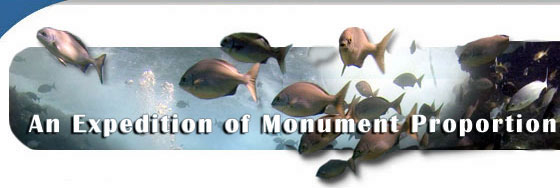|
Mission Log: July 6, 2006
Death of a Laysan Albatross Chick
Patricia Greene
NOAA Teacher-at-Sea
We arrived on Green Island at Kure Atoll and observed thousands of Laysan Albatross, (Phoebastria immutabilis), chicks and fledglings. As we walked the island we noted dead birds among the living. To some extent this may be a natural occurrence. Only one egg is laid and both parents nurture the chick. In the early stages the parents return often with frequent feedings. As the chick matures and becomes older the feedings become less frequent; at this age perhaps just once a week. The parents may travel hundreds, even thousands of miles across the Pacific Ocean far as the Aleutian Islands to forage. Meanwhile, the chicks wait close to their hatching spot for a parent to return.
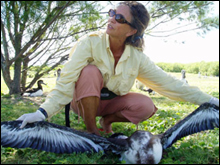 |
| Cynthia Vanderlip selects a newly dead Laysan Albatross to perform a necropsy.(Photo: Claire Fackler/NOAA) |
The parent albatross has a perilous journey. On the way one or both of parents may fall victim to long line fishing or nets, power lines, planes, sharks or other predators. If one parent is killed, the other parent will probably not be able to provide enough food to sustain the chick; the chick will sit and wait for the parents; eventually starve to death, or if it is old enough and ready, it may try its wings and fledge.
In a perfect world untainted by man, our chick’s diet would consist of fish and fish eggs, squid, and octopus. Yet in our world and the “age of plastics” the chick will likely be fed some amazing indigestible, synthetic products.
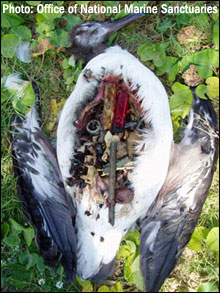 |
| A recently expired Laysan Albatross chick with its belly full of plastic.(Photo: Claire Fackler/NOAA) |
On July 1, 2006, Cynthia Vanderlip conducted a necropsy of a chick that had expired a few hours previous. The “chick” had a wing spread of 5 to 6 feet and weighed approximately 5 lbs. The contents of the bird’s stomach amazed and shocked the teachers and scientists. The dead chick was severely impacted and literally full of plastics. Some pieces were approximately 6 inches long and several were sharp and jagged. We could conclusively state this bird was killed by the plastic debris because of the observed puncture in the lining of the proventriculus. We removed the plastic from our bird and counted an excess of 306 pieces of plastic!
Although a chick may be fed plastics, once they reach fledgling age they are usually able to regurgitate the indigestible material and cleanse their bodies of the plastic. However, if the pieces are too large or in this case, large, sharp and piercing, the bird may die an agonizing death; totally impacted and/or the lining punctured. As we walked the paths of Green Island we observed many young dead albatross. After viewing this incredible necropsy we contemplate how many of these young birds may have met a similar fate to the one we necropsied. Our specimen was chosen at random, selected only because we realized it had died within the last few hours.
Typically, Laysan Albatrosses have a larger volume of ingested plastic than any other seabird because their favored food, flying fish eggs, are attached to floating debris, and in our modern world most of this debris is plastics, where it used to be wood or pumice. Floating is one of the properties of plastics. The most recent research that we had available to us on the island regarding plastics and albatross chicks was published in 1995. According to this research by Auman, Ludwig, Geis, and Colburn: “ingested plastic probably does not cause a significant direct mortality in Laysan Albatross chicks, but likely causes physiological stress as a result of satiation and mechanical blockage. Resulting problems may include; starvation, suppressed appetite, reduced growth rate, lower fledgling masses, obstruction of the gut, and decreased fat deposition.”
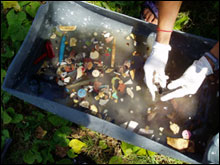 |
| Rinsing 306 pieces of plastic debris from the albatross chick.(Photo: Claire Fackler/NOAA) |
Research suggests there is an upward trend in the volume and mass of plastics found in the Laysan Albatross chicks. In 1966, 74% of 91 chicks contained some plastic, with 8 pieces being the greatest number found and the average mass only 1.87 grams. In the 1994/1995 study 18.1 grams and 23.8 grams respectively. From our recent experience, we could only imagine what the numbers look like now in 2006.
Interestingly, much of the plastic found in the Northwestern Hawaiian Islands is of Japanese origin. As we walked the beach we observed many plastic articles with Japanese writing on them. In the boli from chicks we observed Japanese cigarette lighters and in our specimen there was a piece of plastic with Japanese writing on it. Some of the debris may be from Japanese fishing boats or perhaps from the warm Kuroshiro current that flows from Japan.
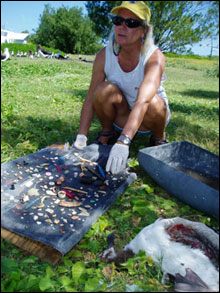 |
| The author, Patty Greene, sorts through the 306 pieces of plastic debris found in a Laysan Albatross chick on Green Island.(Photo: Claire Fackler/NOAA) |
Another concern is when the albatross eats burned or melted plastic parts. These are especially toxic because of release of organochlorines; polychlorinated biphenyls (PCB’s) and phospholipid foams, which can be absorbed and harmful to both the adult birds and their chicks. Many pieces of burnt plastics were observed on the island and in the chick Cynthia conducted a necropsy on.
In a few days, our bird will be gone; devoured by the decomposers and scavengers. At night the ghost crabs will come out of their burrows and feast on him; beetles and fly larvae will clean up the remains. Soon the bird will be reduced to just a pile of feathers but the plastics we found will remain for years.
|

